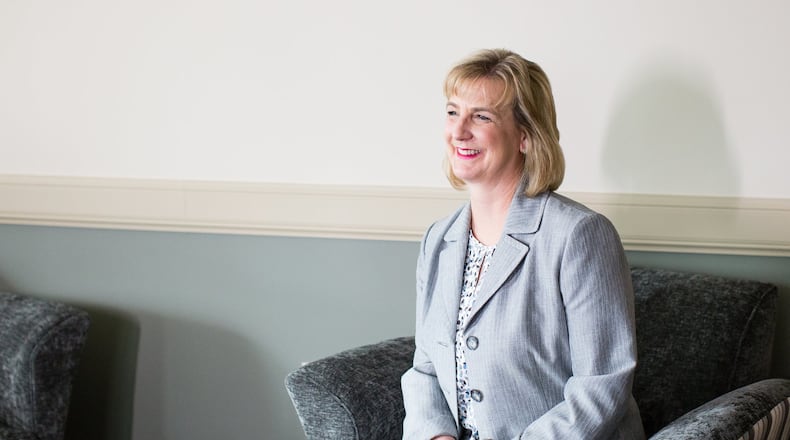RELATED: New Wright State leader on budget cuts, STEM jobs, being first woman president
“Wright State is 50 years old. Missouri S&T is 150 years old, so Wright State got to that ceiling a lot quicker than Missouri S&T did,” Schrader said. “I’d say Wright State is ahead of the game.”
Schrader is part of a select club in higher education. Only around one in four college presidents are women, according to the American Council on Education. In Ohio, Schrader will become one of five women presidents at the state’s 14 public universities.
Even fewer lead research universities, such as WSU or the Missouri S&T where that photo hangs outside the chancellor’s office. Schrader will start her new job at Wright State on July 1, simultaneously breaking another college’s glass ceiling.
When Schrader was named the chancellor of Missouri S&T, people were shocked, administrators said. Schrader walked on-stage at the event celebrating her announcement and at first people assumed her husband was to be S&T’s next leader, said Kate Drowne, associate dean in the college of arts, sciences, business and marketing.
TWEET: Follow reporter Max Filby on Twitter for more higher ed news
“There was an audible gasp when my name was announced,” Schrader said.
When Schrader was announced as WSU’s seventh president last month, she was celebrated as the first woman named to lead the 50-year-old university. WSU trustee Grace Ramos said she was proud that “the glass ceiling has been broken at Wright State.”
When Schrader was in college, it had not occurred to her that she could be an engineering professor or eventually lead a university.
“I believe that’s because I had never actually seen a female engineering professor. I didn’t know that was something that was open to me,” Schrader said. “Leading an institution, even as a young faculty member, probably never crossed my mind.”
Schrader has made it her mission to give women the chance she never thought she would get.
Under her leadership, Missouri S&T has increased the number of women in faculty positions by 36 percent. The number of female students increased by 21 percent under Schrader even though Missouri S&T is historically known as a “men’s school,” faculty said.
Schrader also boosted the number of female faculty and students in Boise State University’s college of engineering, where she previously served as a dean. In 2005, the White House awarded Schrader the Presidential Medal of Excellence in Science, Mathematics and Engineering for bringing more women and minorities into those fields.
“I can smooth the way for other people in a way that perhaps was not available to me,” Schrader said. “That’s my commitment. My passion is to allow people to capture their dreams, regardless of what background they’re from.”
5 HIGHER ED MUST READS
• Ohio State wants to offer more jobs to Ohioans with disabilities
• Sinclair projects record number of graduates this year
• Wright State names new liberal arts dean
• UD grads get and keep jobs better than other Ohio college alums
• Wittenberg University grad falls from roof of house
Women college presidents
Cheryl Schrader is part of a small club in higher education. Just one in four college presidents are women and even fewer lead institutions with bachelor’s and master’s degree programs.
25 percent of all college presidents are women
33 percent of community college presidents are women
23 percent of presidents at institutions with bachelor's and master's programs are women
22 percent of presidents institutions with doctoral degrees are women
Source: American Council on Education’s college president study
About the Author
